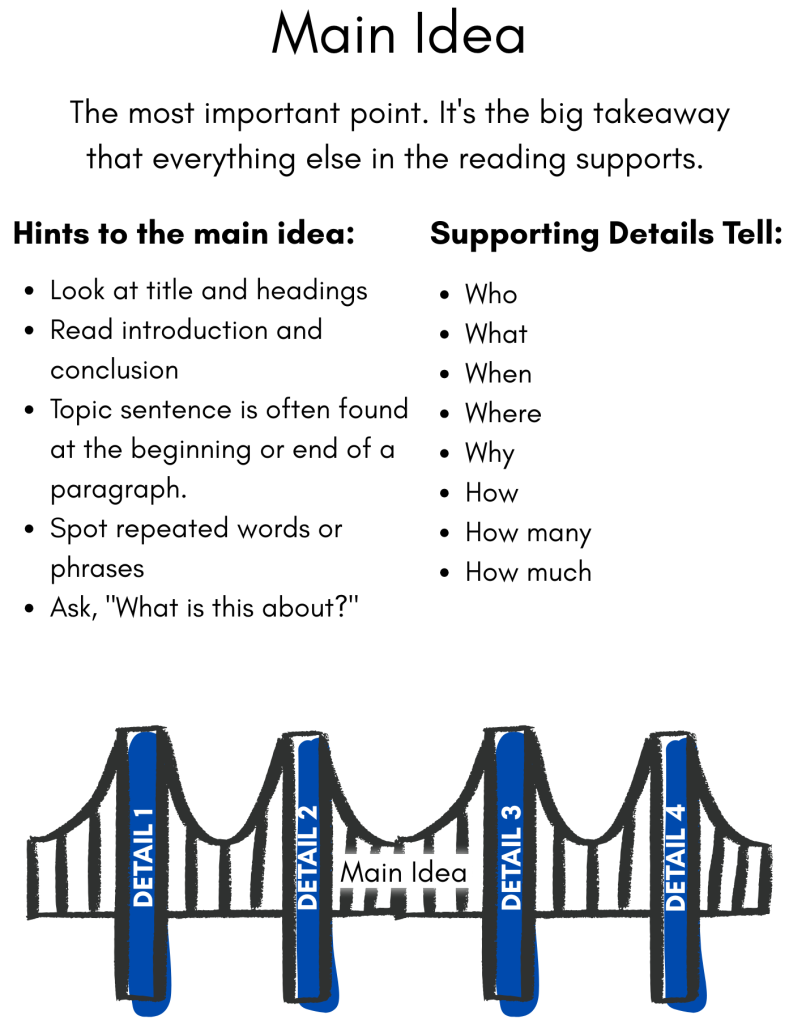3.3 Identifying Main Ideas
Erin Thomas, MFA and Rachel Cox-Vineiz, MA
So What is the Point?
College reading assignments can be dense and dry. The overwhelming number of facts and details can make it difficult to stay awake, let alone keep track of what’s important. However, being able to distinguish between the main idea (or the thesis) and the supporting details of an argument or chapter is key to successful reading and writing in college. Often, the problem is not what we’re reading, but how we’re reading. Successfully identifying main ideas and supporting details can help you focus on the key points of any lecture or text.
Main Idea and Purpose
Every textbook, lecture, or article has a main point, goal, or thesis. Examples of three types of main points are provided in the list below.
- Main points may explain: “Today, we will discuss how to calculate standard deviation.”
- Main points may be intended to persuade: “I believe that one should never eat seafood at Taco Bell, and you should believe this too.”
- Main points can introduce ideas to ponder: “If a tree falls in the woods, and everyone hears it, then why didn’t Ted get out of the way?”
Authors provide proof, arguments, or explanatory facts to support the main idea. Think of these supporting details as the street signs that help you navigate to the final destination: facts, arguments, and details are the directions to get the reader or listener there. Your goal as a student is not to get lost in the details, and following the basic steps below can help you locate the main idea and understand how the details support that idea.
Reading for Main Ideas
The best way to stay on track is to determine the main idea before you dig into a text. Some good places to start include the following:
Headings
Most textbooks have clearly designated headings and subheadings. When taking notes, first look at the main heading and the subtopics. For example, a chapter on “Dogs” could focus on any number of topics, such as breed types or basic pet care. You can determine a chapter’s focus by quickly surveying the chapter subheadings and asking, “How do these ideas fit together? What is the common theme?”
Introductions
Read and analyze the introductory paragraphs before reading the remainder of the text. Introductory paragraphs are typically used to make a formal claim that the remainder of the article or chapter will seek to defend. In other words, the introduction should say something that the author wants to prove or explain.
Conclusions/Summary Paragraphs
If the introduction and headings don’t make it clear what the main idea or ideas of the text are, skip ahead and read the last few paragraphs. Sometimes chapters in the textbooks add summary pages to review main points. Instead of reading them last, use these lists to guide the preview of your reading.

Reflecting
After you’ve got the main points, ask some of the following questions:
- How do I think these ideas will fit together?
- What’s is the author’s main goal? To educate me? Persuade me?
- What does the author think about his or her topic? Is the author biased or objective?
- What information or ideas will the author need to present to successfully make his or her case?
Reading with a Purpose
Now that you’ve determined the answer to these questions and the author’s main point, you’ll have a general idea to guide your reading. While you might have to reevaluate your initial ideas as you come across new details, you’ll be able to better focus on important points and how the argument or chapter flows together.
A good strategy is to identify major opinions and claims, and those details that provide evidence or explanation for each claim. Marking certain sentences with an “E” (evidence) or “C” (claim) can help you keep track as you write your notes.[1]
Media Attributions
- Main Idea Graphic (1) © Rachel Cox-Vineiz is licensed under a CC BY-NC-SA (Attribution NonCommercial ShareAlike) license
- Reading for main ideas vs. details. (2025). University of Cincinnati Learning Commons. https://www.uc.edu/campus-life/learning-commons/learning-resources/notetaking-resources/main-ideas-vs-details.html.html ↵

